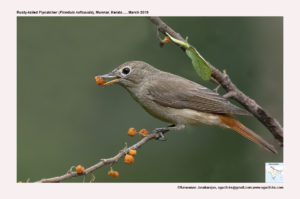Rusty-tailed Flycatcher

Rusty-tailed Flycatcher Muscicapa ruficauda
Etymology:
- Muscicapa : Latin Word musca – fly; capere – to catch
- Ruficauda : Latin word rufus –rufous; caudatus -tailed
Vernacular names: Guj: Lalpunchh makhimar, Badamipunch makhimar, Mal: Chempuvalanpakshi, Mar: Tambus Shepaticha Mashimar
Distribution in India: Breeds in Himalayas and winter visitor in South West India.
Description:Size of 13-14 cm; wt. of 11-16 g. It is a medium-sized, upright forest flycatcher with flat-headed appearance and large dark eye. Head and upperparts are grey-brown, lores to eye and eyering inconspicuously pale buff, brownish line along center of lores; flight-feathers browner, with paler buff-brown edges of tertials and inner secondaries; buff-brown tips of greater upperwing-coverts; rump to tail bright rufous, tip of tail usually browner; mostly dull whitish below, washed buffish on breast and flanks; iris dark; upper mandible dark horn, lower mandible pale yellowish; legs dark grey or blackish. Both the sexes are alike. The juvenile is similar to adult including the rufous uppertail-coverts and tail but with whitish streaks on forehead, buffish spots on mantle and back, buffish wingbars, and dark bars or scaling on underparts.
Habitat:It is found during breeding in open coniferous and broadleaf forests, also mixed deciduous and coniferous forests; at heights of 1500–3600 m. In non-breeding season found in edges and clearings of lowland evergreen forests, up to 1000 m.
Food Habits: It eats small invertebrates like dipteran flies, beetles and moths. It is usually solitary or in pairs in breeding season. It forages in understorey, usually on edges of forest, rather than in interior; unobtrusive, usually detected by alarm calls; bobs forward and flicks wings in chat-like manner. It hunts prey from low perches and by fluttering in foliage; also by aerial pursuits, returning to different perches.
Breeding Habits: They breed in Apr-June in India. The nest is a cup made almost entirely of moss, with additional lichens, gossamer, bark strips, hair and feathers, placed in variety of locations, including in bush, on horizontal branch or against trunk of tree, or on ground in depression or at foot of bush. They lay a clutch of 3–4 eggs.